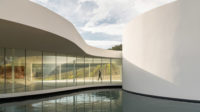Daniel Libeskind’s bold $110 million addition to the Denver Art Museum opened to the public on October 7, 2006. Three weeks later, after a fall snowstorm, the building’s sharply angled roof began to leak. Water could be seen dripping from a skylight in the four-story El Pomar Grand Atrium.


Repairing the roof has proved to be no simple matter. In the past three years, construction workers have become a regular presence at the titanium-clad museum, and visitors must navigate a maze of scaffolding before entering. Denver’s alternative weekly newspaper, Westword, has gone so far as to jokingly refer to the elaborate scaffold as the museum’s “newest conceptual sculpture.”
The lengthy repairs may finally be coming to an end. Museum spokeswoman Kristy Bassuener says the work is scheduled to be completed in November. Why have the repairs taken so long? Bassuener says the work can only be done during the summer months, and the first phase—a temporary fix—was completed in summer of 2007. Last summer, workers made “proactive” repairs to sections of the roof that weren’t leaking. And this summer, some parts of the roof have been permanently resurfaced with a vinyl material by Sarnafil, and the skylights over the atrium have been raised slightly.
Mortenson Construction’s Denver office, which built the new wing, is handling and paying for the repairs. But it’s unclear exactly who is to blame for the leaky roof. Bassuener says “those conversations haven’t taken place yet,” adding, “at this time, the team is solely focused on making repairs that stop the problem, rather than spending time assigning blame.”
A spokesman with Libeskind’s New York office said the architect had no comment about the roof. Brit Probst, a principal at Denver’s Davis Partnership Architects, which collaborated with Libeskind on the museum addition, referred questions to the museum’s staff.
Meanwhile, museum visitors seem to be taking the roof repairs—and the ever-present scaffolding—in stride. In the past year, museum attendance has exceeded projections, with 342,000 people visiting since January. A recent exhibition of 1960s-era psychedelic music posters was so popular that it was extended by one week. And for its next temporary show, “Embrace!”, which opens November 14, the museum has commissioned 17 international artists to create site-specific works inside Libeskind’s building, whose asymmetrical galleries have been criticized for being less-than-ideal settings for art. The show appears to be in part an attempt to refute those criticisms by embracing what deputy museum director and curator Christoph Heinrich calls the building’s “unique spaces.”




Post a comment to this article
Report Abusive Comment